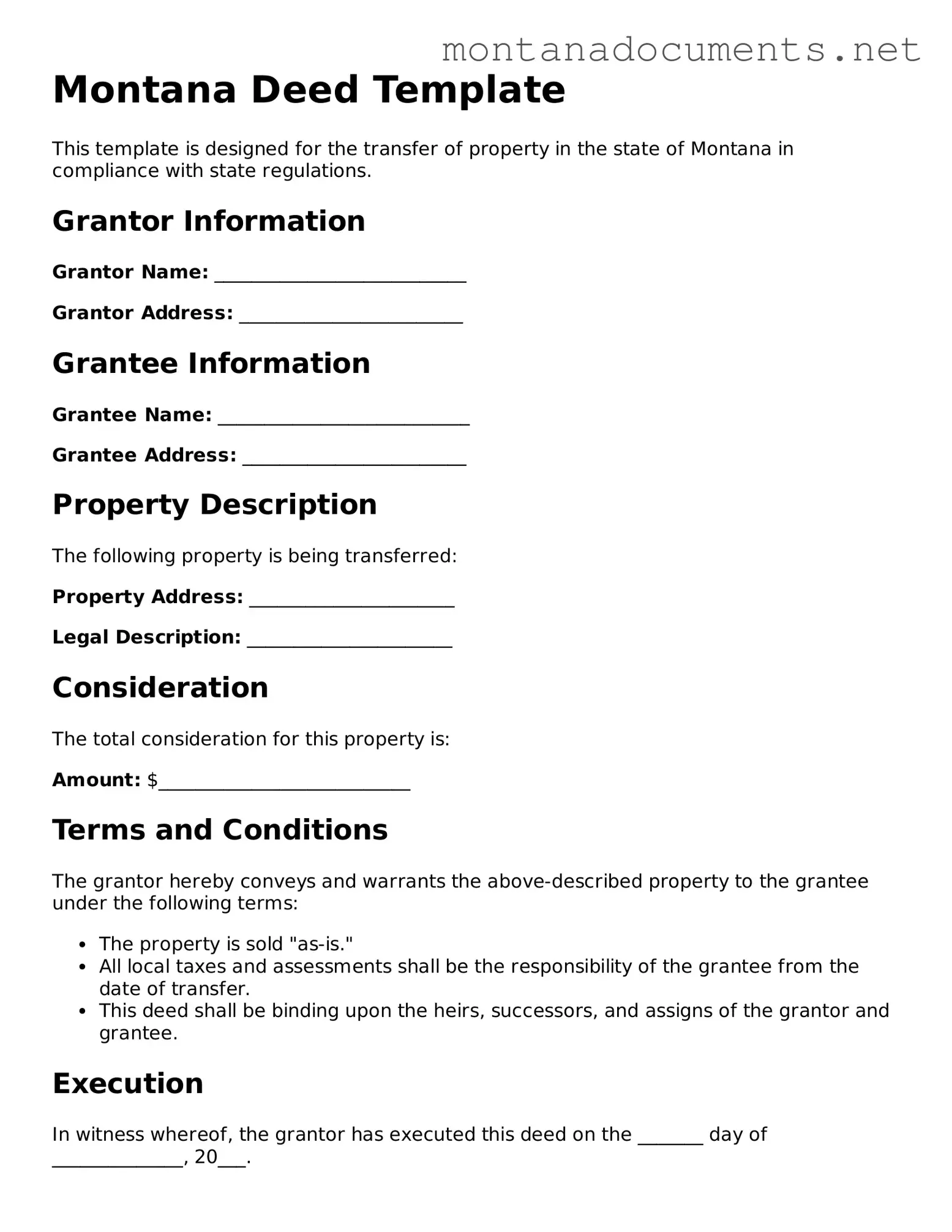The Montana Deed form is quite similar to a Warranty Deed. A Warranty Deed provides a guarantee from the seller to the buyer that the seller holds clear title to the property and has the right to sell it. This type of deed offers protection to the buyer against any future claims on the property, ensuring that the seller is responsible for any issues that may arise regarding ownership. Like the Montana Deed, it is a formal document that must be signed and notarized to be legally binding.
Another document akin to the Montana Deed is the Quitclaim Deed. Unlike a Warranty Deed, a Quitclaim Deed transfers whatever interest the seller has in the property without any warranties. This means that if the seller has no ownership, the buyer receives nothing. This type of deed is often used between family members or in situations where the parties know each other well, and it is less formal than a Warranty Deed.
The Special Warranty Deed is also similar to the Montana Deed. It provides a limited guarantee from the seller, stating that they have not encumbered the property during their ownership. However, it does not protect the buyer against claims that may have arisen before the seller acquired the property. This type of deed is often used in commercial transactions and can be beneficial when the seller wants to limit their liability.
A Bargain and Sale Deed shares similarities with the Montana Deed in that it conveys property ownership but typically does not include warranties. The seller essentially "bargains" the property to the buyer, implying that they have the right to sell it. This type of deed is often used in foreclosure sales, where the seller may not be able to provide full guarantees about the title.
The Grant Deed is another document that resembles the Montana Deed. It conveys ownership of real property and includes a guarantee that the seller has not sold the property to anyone else. Unlike the Warranty Deed, it does not provide a comprehensive guarantee against all claims but does ensure that the title is clear at the time of sale. This makes it a popular choice for straightforward property transfers.
A Deed of Trust is similar in that it is a legal document used in real estate transactions, but it serves a different purpose. It involves three parties: the borrower, the lender, and the trustee. The borrower transfers the property to the trustee, who holds it as security for the loan. If the borrower defaults, the trustee can sell the property to repay the loan. While it is not a deed of ownership transfer like the Montana Deed, it is crucial in securing financing for property purchases.
The Affidavit of Title is a document that can complement the Montana Deed. It is used by sellers to affirm that they hold clear title to the property and disclose any potential issues. This affidavit can provide additional assurance to the buyer and is often used in conjunction with the deed to clarify ownership status and any encumbrances.
The RV Bill of Sale is a crucial document for anyone purchasing a recreational vehicle in California, as it ensures a legal transfer of ownership from the seller to the buyer. Understanding the requirements is essential, and you can find more information about the process in this informative practical RV Bill of Sale guide.
A Leasehold Deed is another document that may appear similar but serves a different function. It grants a tenant the right to use a property for a specified period under certain conditions. While it does not transfer ownership, it establishes the tenant's rights and responsibilities. This can be particularly useful in commercial real estate transactions, where the use of property is often defined by lease agreements.
The Bill of Sale is often used in conjunction with property transactions, particularly for personal property. While it is not a deed for real estate, it serves as a written record that transfers ownership of personal property from one party to another. In real estate transactions, it may accompany the deed to document the sale of any personal property included in the transaction, such as appliances or furniture.
Lastly, the Certificate of Title is similar to the Montana Deed in that it provides proof of ownership. However, it is often used in the context of vehicles or personal property rather than real estate. This document is issued by a government agency and serves as an official record of ownership, ensuring that the title is clear and free from liens. While it differs in application, both documents serve the fundamental purpose of establishing ownership rights.
